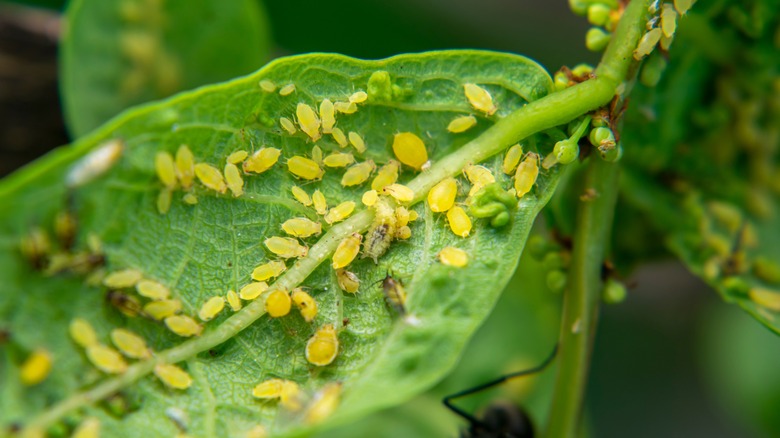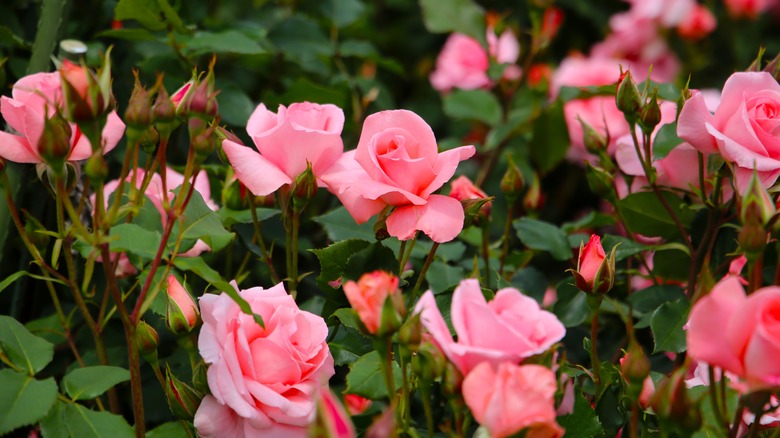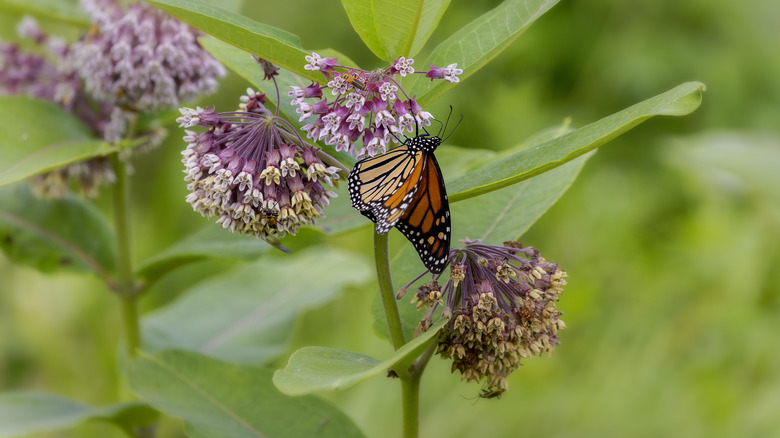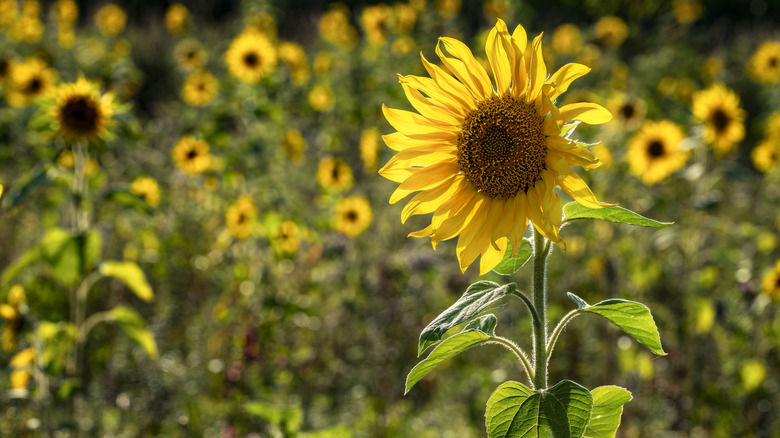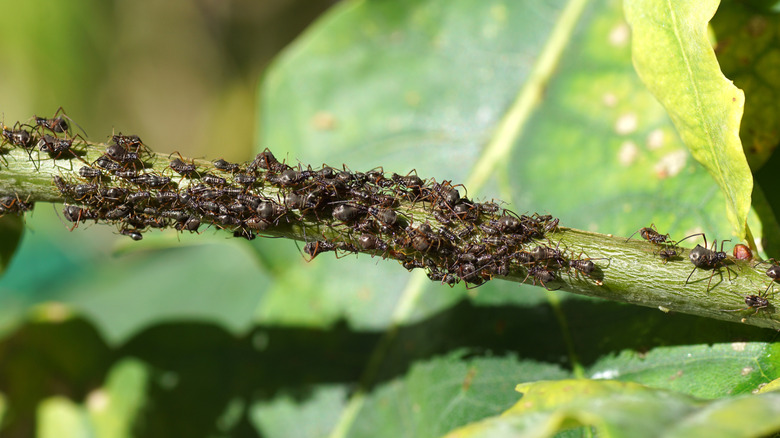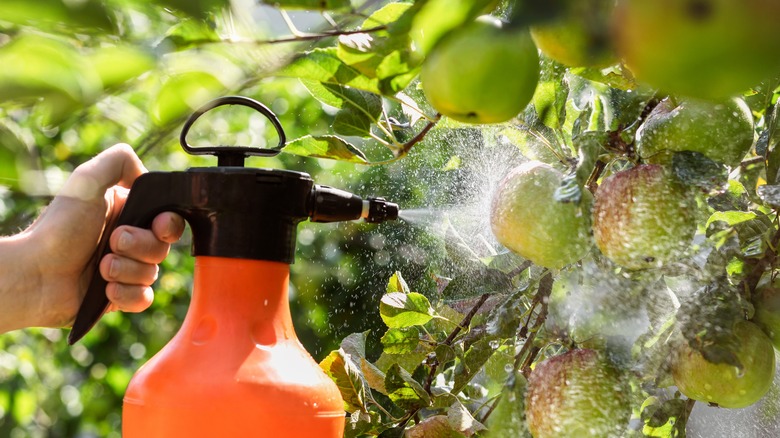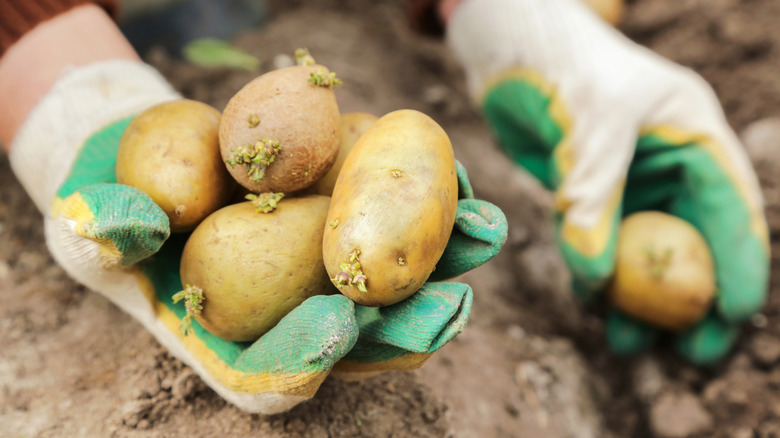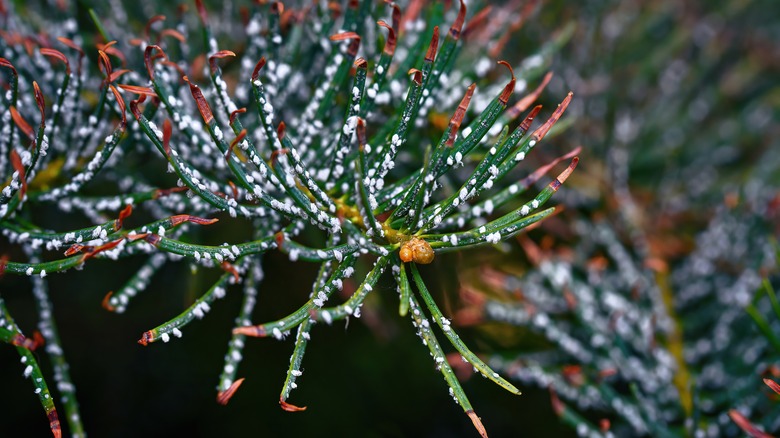These 12 Plants Are Unknowingly Attracting Aphids Into Your Garden
We may receive a commission on purchases made from links.
Aphids are the biggest archnemesis for most gardeners. These soft-body bugs come in a variety of colors, including white, yellow, red, brown, gray, or green. They feed on roses, vegetables in the garden, and even fruit trees. Even weeds aren't immune from aphids. And unfortunately, you might actually be inviting the bugs into your garden without even knowing it by having some of their favorite snacks around — like these 12 plants they love.
Some people call aphids by a not-so-nice nickname: Plant lice. It's no wonder. While aphids might be tiny, sometimes measuring in at just ¹⁄₁₆ of an inch, they can cause a lot of damage. They suck up the sap from plants, often causing withered or yellowed leaves. Even worse, when they feed on plants, they leave behind a sticky residue called "honeydew" on leaves or stems that can attract ants or even yellowjackets.
The best way to kill aphids might be to send them flying with water from your garden hose, since they're easily knocked off and have a lousy sense of direction. Once aphids are removed from their host plant, it's difficult for them to find their way back to it. Another option is to use a nontoxic insecticide like Natria neem oil spray. The reason neem oil works as pest control against aphids is that it interferes with their ability to eat. But the best offense could just be a good defense. Take a look at the plants growing in your garden to make sure they're not rolling out the welcome mat for aphids.
Roses might be some aphids' favorite meal
Aphids love roses because the sweet sap in its leaves, flowers, and stems make for a perfect meal. This weaken the rosebush and can make the plant more susceptible to disease. If want to save your sweet-smelling roses and discourage aphids from snacking on them, try to reduce how much fertilizer you use. Fast-growing cultivars might attract more of the pests than those that grow at a normal pace. If you grow roses, check them often to make sure you don't have an aphid colony in the works.
Milkweed draws in butterflies and aphids
The monarch butterfly isn't the only insect who loves the common milkweed (Asclepias syriaca) wildflower. Aphids love it, too — especially the oleander aphid, which is typically golden-colored. If you see large packs of yellow bugs and the shiny residue of honeydew on their leaves, then you've got an aphid infestation. This can often lead to sooty mold, too. Traditional aphid predators like wasps or ladybugs will steer clear of this particular breed, because the sap they drink from the milkweed makes them poisonous to other bugs.
Aphids want to eat their spinach, too
Aphids, like Popeye, get stronger by eating their spinach. If you've been asking yourself what's eating your spinach in the garden, the answer could be turnip or green peach aphids, who love these leafy greens. They even devour spinach through the winter if you're growing it in temperatures above 50 degrees. To spot the critters, look for tiny bugs beneath the leaves, usually about the size of a pencil point. To avoid using chemical pesticides, try using a dose of soapy water on the leaves.
Sunny sunflowers are the perfect aphid home
While we might love the sunny sunflower, so do some kinds of aphids. Brown ambrosia aphids in particular gravitate to sunflowers (Helianthus annuus L.) and purple coneflowers (Echinacea purpurea). They've also been known to snack on black-eyed Susans, as well. You can identify brown ambrosia aphids because they tend to be brown (thus their name) and pear-shaped. The good news is that they don't tend to kill your flowers or cause major damage, unless there are just so many that they overwhelm the plant.
Aphids love a cucumber salad
Aphids have a preference for salad bar produce, and cucumbers are no exception. The pests adore this crisp fresh vegetable and its juicy leaves. Melon aphids, especially, love to feed on cucumbers. You'll know them by their darker coloring, and will find colonies on the underside of leaves. Melon aphids reproduce rapidly in the spring and summer. If you see white ones, that means they've shed their skin and are maturing quickly. Unfortunately you'll see even more aphids soon, since the skinless, white melon aphids are on their way to being old enough to reproduce.
Oak trees also attract aphids
It's not just vegetables or flowers that draw aphids in. Trees do, too. In particular, oak trees are the perfect home for the black oak aphid. These insects can sometimes look a little like tiny ants, and are only attracted to oaks. Any sort of oak aphid, for example, wouldn't feed on a pine tree. And unfortunately, it can be a lot harder to spray aphids off of a tall tree. So, if you see any signs of these persistent pests on your oak, you might want to look into certain insecticides for oak trees.
An apple a day won't keep aphids away
Spirea aphids or apple aphids, which both look alike, can glom on to your apple tree leaves and make them their new home. You'll know they've moved in if you see leaves start to curl. Adults tend to be lime green, but the eggs they lay are black. They prefer apple trees, but they'll take a pear tree as well. Mostly they live under their favorite young leaves, but if you see some on top of foliage, that means you've got a really big colony.
Long beans and other legumes attract aphids
Long beans (Vigna unguiculata) and other kinds of legumes find themselves on the menu for certain kinds of aphids. If left untreated, the pests can kill entire long bean plants and destroy your harvest. Like many legumes, the long bean can add nitrogen to the soil and make it richer. But if the plant is overtaken by aphids, it might not live to benefit the soil. Not sure if it's aphids on your plant? Check the rear ends of the bugs. All aphids have two cornicles, kind of like dual exhaust pipes.
Watermelon could be an aphid's summer treat
Melon aphids love to snack on juicy watermelon leaves. They tend to come in a variety of shades including white, black, yellow, or green. Even worse, they don't mind the heat of summer, and will thrive even when other bugs need to find comfort in the shade. If you don't want to use insecticide on your watermelon plants, try using rosemary oil to deter these bothersome parasites from making themselves at home. You can also plant aphid-repelling companion plants in the garden, like garlic or chives.
Potatoes plants attract potato aphids
Potato aphids love potatoes, which is, of course, how they got their name. They also target other plants in your vegetable garden, including peppers and eggplants. Potato aphids can appear in shades of either green or pink and they love to live on the underside of potato leaves. These pests don't just suck the sap from the leaves, however. They also spread disease, like potato leafroll. Ladybugs love to eat many kinds of aphids, including potato aphids, so drawing more of these helpful predators to your garden will help keep populations under control.
Pine trees attract woolly aphids
Pine trees aren't immune from aphids, either. A very special breed — named woolly aphids because they're covered in white fuzz — love to munch on their evergreen needles. To treat an infection, hose down your pine tree and cut away severely infected or withered branches, if you can. Those opting for insecticide should make sure to apply it thoroughly inside pine needle clumps. The good news is these woolly aphids aren't likely to kill your pine tree, but they might cause unsightly browning or yellowing of some needles.
Aphids make peach trees not so peachy
The green peach aphid loves peach trees, as well as other fruits and vegetables like potatoes, tomatoes, beans, peppers, and even pumpkins. An interesting fact about green peach aphids is that they find their host crops by the color contrast of the brown bare ground and the green stems or leaves of their target plant. If there's less exposed soil beneath plants then they might get confused and move on. As a preventative measure, you can always try using reflective mulch and see if it works!
